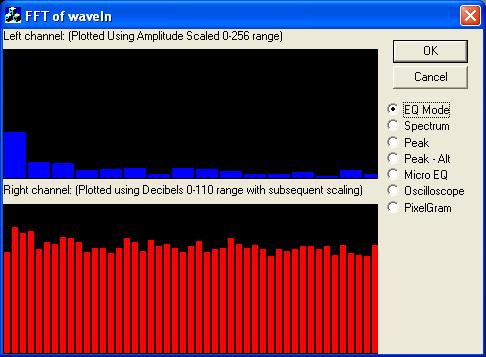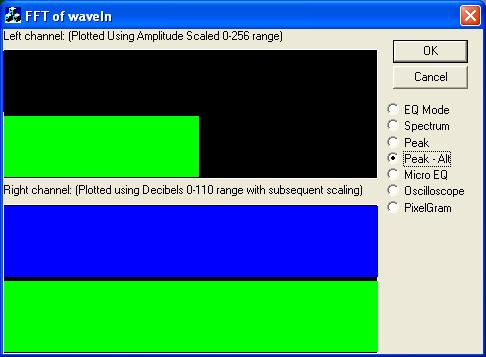音乐频谱显示 FFT of waveIn audio signals. Free source code and programming help
来源:互联网 发布:java 高并发框架 编辑:程序博客网 时间:2024/05/18 01:29





![]()

Introduction
The Fast Fourier Transform (FFT) allows users to view the spectrum content of an audio signal. The FFT code presented here was written by Don Cross, his homepage appears to have subsequently been taken down. Rather than explain the mathematical theory of the FFT, I will attempt to explain its usefulness as it relates to audio signals.
The FFT allows users to obtain the spectral makeup of an audio signal, obtain the decibels of its various frequencies, or obtain the intensity of its various frequencies. Spectral viewers (shown in the image above), Equalizers, or VU-Meters may all use the FFT in order to display their results. The difference between them then depends upon one of a couple of equations that take the real and imaginary components of the FFT, and return either the intensity or decibel levels to be used in the graphed result. The following code takes both the real and imaginary components of the FFT result, and returns the intensity and decibels.
inline double GetFrequencyIntensity(double re, double im){ return sqrt((re*re)+(im*im));}#define mag_sqrd(re,im) (re*re+im*im)#define Decibels(re,im) ((re == 0 && im == 0) ? (0) : 10.0 * log10(double(mag_sqrd(re,im))))#define Amplitude(re,im,len) (GetFrequencyIntensity(re,im)/(len))#define AmplitudeScaled(re,im,len,scale) ((int)Amplitude(re,im,len)%scale)
The FFT uses the audio signal as its real component, and uses a NULL pointer for its imaginary component indicating that the imaginary data does not exist. Upon its return, the FFT will return both the real and imaginary data components based upon the data given as the real component. The is mirrored with the return samples so that 0-FFT_LEN/2 contains the data, and FFT_LEN/2 to FFT_LEN contains a reverse of the data. This mistake was corrected in my code. The code that performs the FFT follows:
DWORD nCount = 0; for (DWORD dw = 0; dw < FFT_LEN; dw++) { { //copy audio signal to fft real component for left channel finleft[nCount] = (double)((short*)pwh->lpData)[dw++]; //copy audio signal to fft real component for right channel finright[nCount++] = (double)((short*)pwh->lpData)[dw]; } } //Perform FFT on left channel fft_double(FFT_LEN/2,0,finleft,NULL,fout,foutimg); float re,im,fmax=-99999.9f,fmin=99999.9f; for(int i=1;i < FFT_LEN/4-1;i++) //Use FFT_LEN/4 since the data is mirrored within the array. { re = fout[i]; im = foutimg[i]; //get amplitude and scale to 0..256 range fdraw[i]=AmplitudeScaled(re,im,FFT_LEN/2,256); if (fdraw[i] > fmax) { fmax = fdraw[i]; } if (fdraw[i] < fmin) { fmin = fdraw[i]; } } //Use this to send the average band amplitude to something int nAvg, nBars=16, nCur = 0; for(int i=1;i < FFT_LEN/4;i++) { nAvg = 0; for (int n=0; n < nBars; n++) { nAvg += (int)fdraw[i]; } nAvg /= nBars; //Send data here to something, //nothing to send it to so we print it. TRACE("Average for Bar#%d is %d/n",nCur++,nAvg); i+=nBars-1; } DataHolder* pDataHolder = (DataHolder*)lpData; // Draw left channel CFrequencyGraph* pPeak = (CFrequencyGraph*)pDataHolder->pData; if (::IsWindow(pPeak->GetSafeHwnd())) { pPeak->SetYRange(0,256); pPeak->Update(FFT_LEN/4,fdraw); } // Perform FFT on right channel fmax=-99999.9f,fmin=99999.9f; fft_double(FFT_LEN/2,0,finright,NULL,fout,foutimg); fdraw[0] = fdraw[FFT_LEN/4] = 0; for(i=1;i < FFT_LEN/4-1;i++) //Use FFT_LEN/4 since the data is mirrored within the array. { re = fout[i]; im = foutimg[i]; //get Decibels in 0-110 range fdraw[i] = Decibels(re,im); if (fdraw[i] > fmax) { fmax = fdraw[i]; } if (fdraw[i] < fmin) { fmin = fdraw[i]; } } //Draw right channel CFrequencyGraph* pPeak2 = (CFrequencyGraph*)pDataHolder->pData2; if (::IsWindow(pPeak2->GetSafeHwnd())) { pPeak2->SetNumberOfSteps(50); //Use updated dynamic range for scaling pPeak2->SetYRange((int)fmin,(int)fmax); pPeak2->Update(FFT_LEN/4,fdraw); }
This code is contained in a callback function that is called every time the waveIn functions return with updated audio signal data. The code that actually performs the FFT looks like:
void fft_double (unsigned int p_nSamples, bool p_bInverseTransform, double *p_lpRealIn, double *p_lpImagIn, double *p_lpRealOut, double *p_lpImagOut){ if(!p_lpRealIn || !p_lpRealOut || !p_lpImagOut) return; unsigned int NumBits; unsigned int i, j, k, n; unsigned int BlockSize, BlockEnd; double angle_numerator = 2.0 * PI; double tr, ti; if( !IsPowerOfTwo(p_nSamples) ) { return; } if( p_bInverseTransform ) angle_numerator = -angle_numerator; NumBits = NumberOfBitsNeeded ( p_nSamples ); for( i=0; i < p_nSamples; i++ ) { j = ReverseBits ( i, NumBits ); p_lpRealOut[j] = p_lpRealIn[i]; p_lpImagOut[j] = (p_lpImagIn == NULL) ? 0.0 : p_lpImagIn[i]; } BlockEnd = 1; for( BlockSize = 2; BlockSize <= p_nSamples; BlockSize <<= 1 ) { double delta_angle = angle_numerator / (double)BlockSize; double sm2 = sin ( -2 * delta_angle ); double sm1 = sin ( -delta_angle ); double cm2 = cos ( -2 * delta_angle ); double cm1 = cos ( -delta_angle ); double w = 2 * cm1; double ar[3], ai[3]; for( i=0; i < p_nSamples; i += BlockSize ) { ar[2] = cm2; ar[1] = cm1; ai[2] = sm2; ai[1] = sm1; for ( j=i, n=0; n < BlockEnd; j++, n++ ) { ar[0] = w*ar[1] - ar[2]; ar[2] = ar[1]; ar[1] = ar[0]; ai[0] = w*ai[1] - ai[2]; ai[2] = ai[1]; ai[1] = ai[0]; k = j + BlockEnd; tr = ar[0]*p_lpRealOut[k] - ai[0]*p_lpImagOut[k]; ti = ar[0]*p_lpImagOut[k] + ai[0]*p_lpRealOut[k]; p_lpRealOut[k] = p_lpRealOut[j] - tr; p_lpImagOut[k] = p_lpImagOut[j] - ti; p_lpRealOut[j] += tr; p_lpImagOut[j] += ti; } } BlockEnd = BlockSize; } if( p_bInverseTransform ) { double denom = (double)p_nSamples; for ( i=0; i < p_nSamples; i++ ) { p_lpRealOut[i] /= denom; p_lpImagOut[i] /= denom; } }}
And it requires the following supporting functions:
///////////////////////////////////////////////////////////// check is a number is a power of 2///////////////////////////////////////////////////////////bool IsPowerOfTwo( unsigned int p_nX ){ if( p_nX < 2 ) return false; if( p_nX & (p_nX-1) ) return false; return true;}///////////////////////////////////////////////////////////// return needed bits for fft///////////////////////////////////////////////////////////unsigned int NumberOfBitsNeeded( unsigned int p_nSamples ){ int i; if( p_nSamples < 2 ) { return 0; } for ( i=0; ; i++ ) { if( p_nSamples & (1 << i) ) return i; }}///////////////////////////////////////////////////////////// ?///////////////////////////////////////////////////////////unsigned int ReverseBits(unsigned int p_nIndex, unsigned int p_nBits){ unsigned int i, rev; for(i=rev=0; i < p_nBits; i++) { rev = (rev << 1) | (p_nIndex & 1); p_nIndex >>= 1; } return rev;}///////////////////////////////////////////////////////////// return a frequency from the basefreq and num of samples///////////////////////////////////////////////////////////double Index_to_frequency(unsigned int p_nBaseFreq, unsigned int p_nSamples, unsigned int p_nIndex){ if(p_nIndex >= p_nSamples) { return 0.0; } else if(p_nIndex <= p_nSamples/2) { return ( (double)p_nIndex / (double)p_nSamples * p_nBaseFreq ); } else { return ( -(double)(p_nSamples-p_nIndex) / (double)p_nSamples * p_nBaseFreq ); }}
The included sample class, CFrequencyGraph, will draw a sample EQ, peak meter, and spectral graph using the frequency intensity. Hopefully, this serves as a decent introduction to the uses and basics of the Fast Fourier Transform for audio signals. Other functions of the FFT include using it in combination with a Beat Detection Algorithm to detect beats in an audio signal. Another page with useful FFT information is located at FFT Spectrum Analyser.
This article uses waveIn* functions to retrieve the soundcard's data from the playing source. Therefore, you must manually open your soundcard properties and change the recording source to use mono/stereo mix or waveIn as the selected recording line. Also, if you set the playback wave option to false, this will override the recording options and no sound will appear. For information about doing an inverse FFT for transforming frequencies into an audio signal, please do a Google search on "Inverse FFT" or "IFFT".
History
- Version 1.3: Fixed Spectrum drawing, Changed Pixelgram color, changed Process routine to match new Recording parameters.
- Version 1.2: Fixed many drawing bugs, changed to use amplitude scaled and decibels.
- 音乐频谱显示 FFT of waveIn audio signals. Free source code and programming help
- FFT of waveIn audio signals
- FFT of waveIn audio signals
- Serial library for C++. Free source code and programming help
- CodeProject: MP3FileInfo - Extract Header and ID3 Tags of an MP3 File. Free source code and programming help
- CodeProject: Collapsible, resizable and dockable XP style control bar. Free source code and programming help
- CodeProject: EasySize - Dialog resizing in no time!. Free source code and programming help
- CodeProject: EasySize - Dialog resizing in no time!. Free source code and programming help
- STM32F4 FFT 音乐频谱 不要太easy!
- Free Numerical, Mathematical, Statistics Libraries and Source Code
- List of free and open source SCADA software
- List of free and open source software packages
- nginx Remote Source Code Disclosure and Denial of Service Vulnerabilities
- Corporation of cuda and openGL Texture( Source Code sample)
- List of Free Programming books
- List of Free Programming books
- Source Code of exe2com.
- Source Code of exe2com
- delphi 中关于 The DecisionCube capacity is low. Please deactivate dimensions or change the data set 错误的处理
- Web版tank大战
- 在ORACLE、MSSQL、MYSQL中树结构表递归查询的实现方法
- 一些常用的shell模式
- memcached 基础
- 音乐频谱显示 FFT of waveIn audio signals. Free source code and programming help
- 王小云
- memcached 内存存储
- CPU外频、FSB前端总线和内存频率的关系
- linux系统信息查看 基本命令
- linux 系统管理命令详解
- 只能输入数字的输入框(input)例子
- 文件下载时,只弹出下载框,不在页面打开的方法。
- 通用的模式弹出窗口(适用于IE,Firefox,Opera,Netscape)


